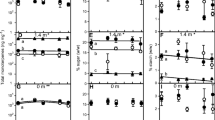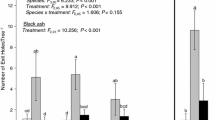Abstract
The responses of five experimental genotypes and one commercial variety of kiwifruit (Actinidia chinensis) to attack by two polyphagous, congeneric armoured scale insect pests (Hemiberlesia rapax and H. lataniae) are described. H. lataniae feeding elicits a response in the bark and fruit of all but one of the experimental genotypes, leading to the development of wound periderm over a 4–5 week period, and death of the insect. The response, which differs slightly between tissue types and genotypes, consists of wound periderm formation in a bowl shape beneath and around the insect, preventing its stylet from reaching normal unmodified parenchyma tissue. Wound periderm cell walls become suberised and cells beneath the insect become filled with phenolic compounds. In some cases, cells beneath the insect become hypertrophic or undergo lysis, exhibiting characteristics of a hypersensitive-like response. The remaining genotype showed no physical change in tissue structure in response to H. lataniae feeding, and the insects survived but were substantially reduced in size. These results suggest that both physical and chemical plant resistance responses are involved. In contrast, H. rapax elicited no observable histological response from any of the genotypes and the insects developed normally on bark and fruit. Both insect species developed normally on leaf petioles and these exhibit only slight cell wall thickening in response to their feeding. This unusual plant defensive response to a sucking insect has similarities to simple types of gall formation in response to insect and pathogen attack and has characteristics of resistance gene-mediated models of plant defence.












Similar content being viewed by others
References
Beardsley JW, Gonzales RH (1975) The biology and ecology of armoured scales. Annu Rev Entomol 20:47–73
Biggs AR (1989) Temporal changes in the infection court after wounding of peach bark and their association with cultivar variation in infection by Leucostoma persoonii. Phytopathology 79(5):627–630
Blank L, Dietrich A, Eimert K, Geier T, Wolf T, Schroder MB (2009) Identification of candidate genes involved in phylloxera resistance in grapevine rootstocks. Acta Hortic 839:427–432
CABI (2009) Crop protection compendium. CABI. http://www.cabicompendium.org/cpc/home.asp. Date accessed 14 Jan 2010
Callow JA, Ling IT (1973) Histology of neoplasms and chlorotic lesions in maize seedlings following the injection of sporidia of Ustilago maydis (DC) Corda. Physiol Plant Pathol 3(4):489–494
Cheng CH, Seal A, Boldingh H, Marsh K, MacRae EA, Murphy S, Ferguson AR (2004) Inheritance of taste characters and fruit size and number in a diploid Actinidia chinensis (kiwifruit) population. Euphytica 138:185–195
Clausen MH, Willats WGT, Knox JP (2003) Synthetic methyl hexagalacturonate hapten inhibitors of anti-homogalacturonana monoclonal antibodies LM5, JIM5 and JIM7. Carbo Res 338:1791–1800
Cornelissen TG, Negreiros D, Fernandes GW (2005) Plant resistance gainst gall-forming insects: the role of hypersensitivity. In: Smith CM (ed) Plant resistance to arthropods. Springer, Manhattan, KS, pp 137–152
Dietrich A, Wolf T, Eimert K, Schroder MB (2009) Investigation of the hypersensitivity reaction (HR) of the ‘Borner’ rootstock. Acta Hortic 827:545–550
Edwards R, Carraher C, Todd JH, Dobson S, Mauchline N, Hill G, McKenna C, Newcomb R (2008) DNA diagnostics of three armored scale species on kiwifruit in New Zealand. J Econ Entomol 101(6):1944–1949
Evert R (2006) Esau's Plant Anatomy. Meristems, cells, and tissues of the plant body – their structure function, and development. 3rd edition. Wiley, Hoboken, New Jersey, p 601
Fernandes GW (1990) Hypersensitivity: a neglected plant resistance mechanism against insect herbivores. Environ Entomol 19(5):1173–1182
Fernandes GW, Negreiros D (2001) The occurrence and effectiveness of hypersensitive reaction against galling herbivores across host taxa. Ecol Entomol 26(1):46–55. doi:http://dx.doi.org/10.1046/j.1365-2311.2001.00290.x
Franceschi VR, Krokene P, Krekling T, Christiansen E (2000) Phloem parenchyma cells are involved in local and distant defense responses to fungal inoculation or bark-beetle attack in Norway spruce (Pinaceae). Am J Bot 87(3):314–326
Greenberg JT, Yao N (2004) The role and regulation of programmed cell death in plant-pathogen interactions. Cell Microbiol 6:201–211
Gullan P, Miller D, Cook L (2005) Gall-inducing scale insects (Hemiptera: Sternorrhyncha: Coccoidea. In: Raman A, Schaefer C, Withers T (eds) Biology, ecology and evoluation of gall-inducing arthropods, vol 1. Science Publishers, Enfield, NH, pp 159–231
Hallett IC, Sutherland PW (2005) Structure and development of kiwifruit skins. Int J Plant Sci 166(5):693–704
Harper LJ, Schonrogge K, Lim KY, Francis P, Lichtenstein CP (2004) Cynipid galls: insect-induced modifications of plant development create novel plant organs. Plant Cell Environ 27(3):327–335
Heriot AD (1934) The renewal and replacement of the stylets of sucking insects during each stadium, and the method of penetration. Can J Res 11:602–612
Hilker M, Meiners T (2006) Early herbivore alert: insect eggs induce plant defense. J Chem Ecol 32:1379–1397
Hill MG, Mauchline N, Cate LR, Connolly PG (2005) A technique for measuring the growth rate of armoured scale insects. NZ Plant Prot 58:288–293
Hill MG, Mauchline N, Cheng CH, Connolly PG (2007) Measuring the resistance of Actinidia chinensis to armoured scale insects. Acta Hortic 753:685–692
Hill MG, Mauchline NA, Hall AJ, Stannard KA (2009) Life table parameters for two armoured scale insect species on resistant and susceptible kiwifruit (Actinidia sp.) germplasm. N Z J Crop Hortic Sci 37(4):335–343
Hill MG, Henderson RC, Mauchline NA (2011) Diaspidid (Hemiptera:Coccoidea) size plasticity as an adaptive life history trait. Eur J Entomol 108:153–159
Hoff RJ, McDonald GI (1972) Resistance of Pinus armandii to Cronartium ribicola. Can J Forest Res 2(3):303–307
Kaloshian I (2004) Gene-for-gene disease resistance: bridging insect pest and pathogen defense. (Special issue: Molecular chemical ecology). J Chem Ecol 30(12):2419–2438. doi:http://dx.doi.org/10.1007/s10886-004-7943-1
Kaplan DT, O’Bannon JH (1981) Evaluation and nature of citrus nematode resistance in Swingle citrumelo. P Fl St Hortic Soc 94:33–36
Larew H (1990) Gall formation. In: Rosen D (ed) Armored scale insects, their biology, natural enemies and control, vol 4A. Elsevier, Amsterdam, Netherlands, pp 293–300
Liphschitz N, Mendel Z (1989) Interactions between hosts and non-hosts of Pinus spp. and Matsucoccus josephi: anatomical responses of stem to infestation. New Phytol 113(2):135–142
Miller DR, Davidson JA (2005) Armoured scale insect pests of trees and Shrubs. Cornell University Press, Ithaca, 442 pp
Mizuta T (2003) Differences in development and reproduction of the mulberry scale, Pseudaulacaspis pentagona Targioni (Hemiptera: Diaspididae), on resistant and susceptible varieties of tea plant. Jpn J Appl Entomol Z 47(3):91–95
Mizuta T (2005) Studies on the mechanism of Pseudaulacaspis pentagona (Targioni) (Hemiptera: Diaspididae) resistance of tea plant and its practical use B Miyazaki Agric Exp Stn (Jpn) 40:1–54
Normark BB, Johnson NA (2010) Nich Explosion. Genetica. doi:10.1007/s10709-010-9513-5
Rosen DE (1990) Armored scale insects: their biology, natural enemies and control, vol 4A and 4B. World Crop Pests, Elsevier, Amsterdam, The Netherlands
Roush TL, Granett J, Walker MA (2007) Inheritance of gall formation relative to phylloxera resistance levels in hybrid grapevines. Am J Enol Viticult 58(2):234–241
Ruzin SE (1999) Plant microtechnique and microscopy. Oxford University Press, New York
Sabba RP, Lulai EC (2002) Histological analysis of the maturation of native and wound periderm in potato (Solanum tuberosum L.) tuber. Ann Bot 90(1):1–10. doi:http://dx.doi.org/10.1093/aob/mcf147
Solla A, Tomlinson F, Woodward S (2002) Penetration of Picea sitchensis root bark by Armillaria mellea, Armillaria ostoyae and Heterobasidion annosum. Forest Path 32(1):55–70. doi:http://dx.doi.org/10.1046/j.1439-0329.2002.00265.x
Stuible HP, Kombrink E (2004) The hypersensitive response and its role in disease resistance. In: Punja ZK (ed) Fungal disease resistance in plants: biochemistry, molecular biology, and genetic engineering. CRC Press, New York, pp 57–92
Sutherland PW, Hallett IC, McRae EA, Fisher M, Redgewell RE (2004) Cytochemistry and immunolocalisation of polysaccharides and proteoglycans in the endosperm of green Arabica coffee beans. Protoplasma 223:203–211
Tanaka J, Taniguchi F (2007) Tea. In: Genome mapping and molecular breeding in plants, vol 6. Technical Crops. Springer, Berlin, pp 119–125
Washington JR, Walker GP (1990) Histological studies of California red scale (Homoptera: Diaspididae) feeding on citrus. Ann Entomol Soc Am 83(5):939–948
Yamada T, Ito S (1993) Histological observations on the responses of pine species, Pinus strobus and P. taeda, resistant to Bursaphelenchus xylophilus infection. Ann Phytopath Soc Jpn 59(6):659–665
Yasuda S (1979) Microscopic observations on the external morphology of Pseudaulacaspis pentagona Targioni and on the portion of mulberry tissues inserted with the stylet. Jpn J Appl Entomol Z 23(2):61–68
Zweigelt F (1931) Blattlausgallen. Histologische und biologische Studient an Tetraneuroa—und Schizoneuragallen. Die Blattlausgallen im Dienste prinzipieller Gallenforschung. Mg Ange Entomol: (Supplement to Zeich Ange Entomol 27)11:1–684
Acknowledgments
We are indebted to Margaret McCully, CSIRO, for advice on interpretation of the histological responses observed. Erik Rikkerink, Graham Walker and an anonymous reviewer provided comments on earlier drafts. The New Zealand Foundation for Research Science and Technology (C06X0301) provided funding support.
Author information
Authors and Affiliations
Corresponding author
Additional information
Handling Editor: Gimme Walter.
Electronic supplementary material
Below is the link to the electronic supplementary material.
Rights and permissions
About this article
Cite this article
Hill, M.G., Mauchline, N.A., Jones, M.K. et al. The response of resistant kiwifruit (Actinidia chinensis) to armoured scale insect (Diaspididae) feeding. Arthropod-Plant Interactions 5, 149–161 (2011). https://doi.org/10.1007/s11829-011-9124-9
Received:
Accepted:
Published:
Issue Date:
DOI: https://doi.org/10.1007/s11829-011-9124-9




